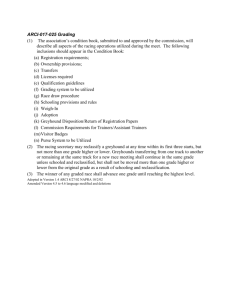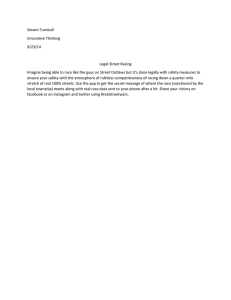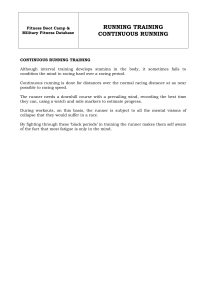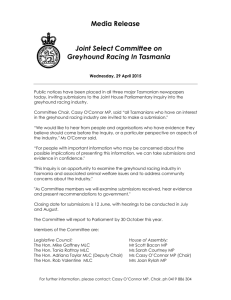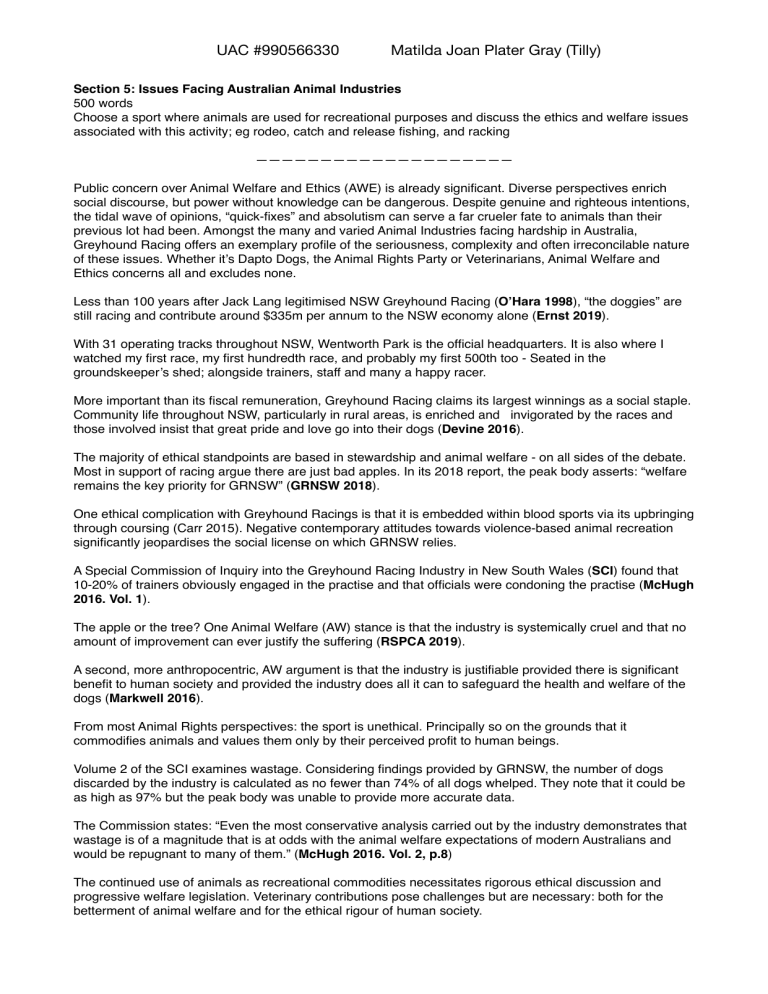
UAC #990566330 Matilda Joan Plater Gray (Tilly) Section 5: Issues Facing Australian Animal Industries 500 words Choose a sport where animals are used for recreational purposes and discuss the ethics and welfare issues associated with this activity; eg rodeo, catch and release fishing, and racking ———————————————————— Public concern over Animal Welfare and Ethics (AWE) is already significant. Diverse perspectives enrich social discourse, but power without knowledge can be dangerous. Despite genuine and righteous intentions, the tidal wave of opinions, “quick-fixes” and absolutism can serve a far crueler fate to animals than their previous lot had been. Amongst the many and varied Animal Industries facing hardship in Australia, Greyhound Racing offers an exemplary profile of the seriousness, complexity and often irreconcilable nature of these issues. Whether it’s Dapto Dogs, the Animal Rights Party or Veterinarians, Animal Welfare and Ethics concerns all and excludes none. Less than 100 years after Jack Lang legitimised NSW Greyhound Racing (O’Hara 1998), “the doggies” are still racing and contribute around $335m per annum to the NSW economy alone (Ernst 2019). With 31 operating tracks throughout NSW, Wentworth Park is the official headquarters. It is also where I watched my first race, my first hundredth race, and probably my first 500th too - Seated in the groundskeeper’s shed; alongside trainers, staff and many a happy racer. More important than its fiscal remuneration, Greyhound Racing claims its largest winnings as a social staple. Community life throughout NSW, particularly in rural areas, is enriched and invigorated by the races and those involved insist that great pride and love go into their dogs (Devine 2016). The majority of ethical standpoints are based in stewardship and animal welfare - on all sides of the debate. Most in support of racing argue there are just bad apples. In its 2018 report, the peak body asserts: “welfare remains the key priority for GRNSW” (GRNSW 2018). One ethical complication with Greyhound Racings is that it is embedded within blood sports via its upbringing through coursing (Carr 2015). Negative contemporary attitudes towards violence-based animal recreation significantly jeopardises the social license on which GRNSW relies. A Special Commission of Inquiry into the Greyhound Racing Industry in New South Wales (SCI) found that 10-20% of trainers obviously engaged in the practise and that officials were condoning the practise (McHugh 2016. Vol. 1). The apple or the tree? One Animal Welfare (AW) stance is that the industry is systemically cruel and that no amount of improvement can ever justify the suffering (RSPCA 2019). A second, more anthropocentric, AW argument is that the industry is justifiable provided there is significant benefit to human society and provided the industry does all it can to safeguard the health and welfare of the dogs (Markwell 2016). From most Animal Rights perspectives: the sport is unethical. Principally so on the grounds that it commodifies animals and values them only by their perceived profit to human beings. Volume 2 of the SCI examines wastage. Considering findings provided by GRNSW, the number of dogs discarded by the industry is calculated as no fewer than 74% of all dogs whelped. They note that it could be as high as 97% but the peak body was unable to provide more accurate data. The Commission states: “Even the most conservative analysis carried out by the industry demonstrates that wastage is of a magnitude that is at odds with the animal welfare expectations of modern Australians and would be repugnant to many of them.” (McHugh 2016. Vol. 2, p.8) The continued use of animals as recreational commodities necessitates rigorous ethical discussion and progressive welfare legislation. Veterinary contributions pose challenges but are necessary: both for the betterment of animal welfare and for the ethical rigour of human society. UAC #990566330 Matilda Joan Plater Gray (Tilly) References 1. Carr, N. 2015. “The Greyhound: A Story of Fashion, Finances and Animal Rights.” In Domestic Animals and Leisure. Edited by N. Carr, 109-126. Basingstoke: Palgrave Macmillan. 2. Devine, M. 2016. Why banning greyhound racing hurts us all. News Corp Australia Network. 3. Ernst, K. 2017 “New South Wales Greyhound Racing.” Australian Greyhound Racing. Sydney: Race Media. australianracinggreyhound.com/new-south-wales. 4. Freire, R. et al. 2015. “The First Shared Online Curriculum Resources for Veterinary Undergraduate Learning and Teaching in Animal Welfare and Ethics in Australia and New Zealand.” Animals, vol. 5, no. 2, pp. 395–406., doi:10.3390/ani5020362. 5. Markwell, K., Firth T., and Hing N. 2016. “Blood on the race track: an analysis of ethical concerns regarding animal-based gambling.” In Annals of Leisure Research. Tasmania: Taylor & Francis. 6. McHugh, M. 2016. Special Commission of Inquiry into the Greyhound Racing Industry in New South Wales. Vol. 1&2. Canberra: State of NSW. 7. National Museum of Australia. 2019. “Great Depression.” National Museum of Australia. Canberra. Australian Government. www.nma.gov.au/defining-moments/resources/great-depression. 8. O’Hara, J. 1998. A Mug’s Game: A History of Gaming and Betting in Australia. Sydney: NSW University Press. 9. OLGR, Office of Liquor, Gaming and Racing. 2014. Size and Scope of the NSW racing industry. Canberra: NSW Government. 10.RSPCA, Knowledgebase. 2019. “What Are the Animal Welfare Issues with Greyhound Racing?” Australia: RSPCA Knowledgebase. kb.rspca.org.au/knowledge-base/what-are-the-animal-welfareissues-with-greyhound-racing.
